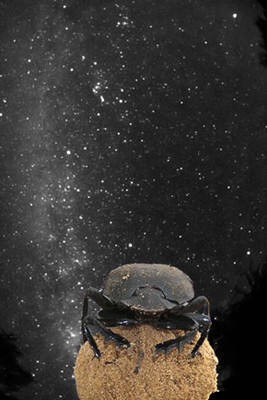(单词翻译:单击)
中英文本
Science and technology
科学技术
How dung beetles navigate
蜣螂如何导航
Stars in their eyes
眼里有星辰
An insect that steers by the Milky Way
观天识途的昆虫
THE number of animals that navigate by the stars is small.
靠观察星辰行走的动物不多。
Only some birds, a few seals and, of course, humans have the ability.
仅仅有某些鸟类、海豹,当然人也有这个本事。
It had been assumed that other creatures that might do this would need reasonably well-developed brains.
过去人们设想其他具备这种能力的生物很可能拥有发达的大脑。

That notion has now been proved wrong as the celestial-navigation club welcomes its latest member: the humble dung beetle.
现在这种见解被推翻了,因为天文导航俱乐部迎来了自己最新的成员—不起眼的蜣螂。
Life in the world of dung beetles is fiercely competitive.
蜣螂在这个世界上过着你争我夺的生活。
After rolling up a ball of highly nutritious dung, the beetle must race off with it or risk having the ball stolen by other beetles.
蜣螂必须把自己团好的极富营养的粪球搬走,否则劳动成果会被其他的蜣螂偷走。
Strength is important, but so too is the route taken.
力量很重要,运输路线也不能轻视。
The ideal tactic on the open plains where many dung beetles live is to move in a straight line.
很多生活在广阔平原上的蜣螂采用走直路的理想策略。
This is easy enough during the day, but at night—when the beetles are most active—it is more challenging.
这在白天不难办到,然而晚上才是蜣螂最活跃的时间,此时走直路对它们来说就是挑战了。
Previous work has shown that dung beetles can make use of the moon to help them navigate, yet some still set a straight course on moonless nights.
以前人们发现蜣螂利用月亮导航,如果晚上没有月亮,也有蜣螂走直路。
To find out how, a team working in South Africa led by Eric Warrant and Marie Dacke, of Lund University in Sweden, designed an intriguing experiment.
为了找到蜣螂夜里能走直路的原因,Eric Warrant和Marie Dacke领导的瑞典隆德大学工作团在南非设计了一个有意思的试验。
They made caps for 19 dung beetles.
他们给19只蜣螂做了帽子。
Ten wore caps made of cardboard to prevent them seeing the sky and, as a control, nine wore caps made of transparent plastic.
10只蜣螂戴着薄纸板做的帽子,这样他们就看不到天空了。作为对比,其他9只蜣螂戴上了透明塑料制成的帽子。
The beetles and their dung balls were then released in the centre of a circular arena made of flattened sand and enclosed by a featureless circular wall.
这些蜣螂和它们的粪球都被放在了一个平铺着沙子圆形场地的中央,场地的围墙也没有什么特别之处。
As the beetles rolled away under a moonless night sky they were filmed by infra-red cameras.
在没有月亮的晚上,红外线摄影机记录蜣螂搬运粪球的活动。
The team found that the beetles prevented from seeing the sky by their caps had path lengths that averaged 476.7cm, much longer than the average of 143.4cm travelled by the beetles wearing clear hats.
试验人员发现被帽子遮挡了天空的蜣螂平均行走476.7cm,远远超出戴着透明帽子的蜣螂的平均路程143.4cm。
As the beetles might have used other overhead landmarks, like trees,
因为蜣螂可能使用位于高处的其他地标。
a second arena was built with a high black wall and a small, dry moat around it.
第二个场地是黑色高墙围起来的,
This time the beetles—minus their hats—were timed to see how long it took them to roll their balls from the centre to the point where they could be heard falling into the moat.
附近有一条干涸的壕沟—这次蜣螂没有戴帽子—实验人员要看看他们从场地中央滚粪球到跌入壕沟能用时多久。
Under a full moon the beetles took an average of 21.4 seconds to reach the moat.
满月之夜蜣螂抵达壕沟平均耗时21.4秒。
On a moonless, starry night, their speed was somewhat reduced, but not significantly so.
在繁星满天的无月之夜,它们的速度有所下降,但降得不多。
However, under overcast conditions, when neither moonlight nor the stars were visible, the beetles took an average of 117.4 seconds.
如果晚上阴天,看不到星星和月亮,蜣螂抵达目的地要平均耗时117.4秒。
Curious as to what it was in the sky that the beetles were using to navigate, the team moved their arena inside the Johannesburg planetarium and reran their experiments.
因为试验人员急于了解蜣螂到底利用天上的什么物体导航,他们到约翰内斯堡天文馆做室内实验。
As they report in Current Biology, the beetles presented with a full starlit sky, including the Milky Way or just the Milky Way, took statistically the same amount of time to exit the arena.
他们在《当代生物学》杂志上统计了蜣螂在繁星满天的夜空下走出场地用的时间在统计学上是相同的,
Under a sky full of dim stars they were only a little slower.
天上的星光不亮,它们要稍微慢一点。
This, speculates Dr Warrant, is because they were still able to spot the cluster that forms the Milky Way.
通过试验Warrant,博士推测,这是因为蜣螂还能认出银河系形成的星团。
When allowed to see only the 18 brightest stars or immersed in total darkness, the beetles took more than twice as long to exit the arena.
如果暗夜里只有18颗最亮的星星,蜣螂离开场地的时间要高出两倍以上。
The team now wonders how many other animals might be able to use the glowing strip of light created by the Milky Way to guide them.
这个团队的工作人员现在想知道到底有多少动物可以利用银河系形成的发光带活动。
词语解释
1.roll up 卷起; 卷成圆筒形
We are going to have to roll up sleeves together.
我们必须一起卷起袖子。
Women, place pens behind your ears and roll up your sleeves.
女士们,耳朵后面加根笔、还要挽起袖子。
2.race off 引诱
Sailboats race each other off the coast of england near cowes.
英格兰海岸附近的考斯帆船比赛。
In the ensuing arms race to show off and get a mate it has been exaggerated in the way that a peacock's tail is.
在炫耀自己并获得伴侣的追求竞争中,这种适应性会以像孔雀尾巴这种夸张的形式出现。
3.make use of 使用,利用;假借
Now we need to make use of them.
如今,我们需要对它们加以利用。
Researches make use of online surveys to complete their assignments.
研究人员利用网上调查来完成他们的任务。
4.made of 由...制成
Is your shirt made of cotton?
你的衬衫是用棉布做的吗?
Modern clock made of small plate pieces assembled at random.
用小碟片随意拼凑而成的时尚时钟。


